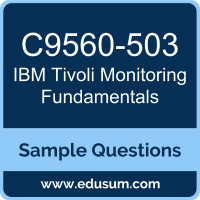01. Which statement is true about sampled events?
a) Sampled events occur automatically.
b) Sampled events are closed automatically.
c) Sampled events require an Until condition.
d) Sampled events are unsolicited notifications.
02. Which statement is true regarding IBM Tivoli Monitoring V6.3 historical data collection?
a) The historical data is only written once a day.
b) The historical data is stored in tables, one table for each agent type.
c) It is possible to collect data twice or more for the same attribute group on a managed system.
d) The Warehouse Proxy agent provides the ability to customize the length of time to prune data.
03. What are two ways to verify the UNIX OS agent is running on a UNIX system?
(Choose two.)
a) Log in to the Tivoli Enterprise Portal Server and verify the UNIX OS agent is providing data.
b) Run the ps -ef | grep kuxagent command and look for a line with kuxagent and its associated process identifier.
c) Run the cinfo -R command. Look for a line with un under the Prod column. Under the Status column, it should say Running.
d) Run the cinfo -r command. Look for a line with un under the Prod column. Under the Status column, it should say Running.
e) Run the cinfo command. Select Option 2: Show which products are currently running. Look for a line with ux under the Prod column. Under the Status c
04. Which action is required to associate a situation with a Navigator item?
a) Select Associate with this Object.
b) Select the Situation filter object box.
c) Select the association object filter check box.
d) Define the Navigator item in the Situation Editor.
05. What is the default Navigator view in Tivoli Enterprise Portal?
a) Logical
b) Physical
c) Enterprise
d) Hierarchical
06. Which statement is true about application support?
a) Application support is automatically applied to the Tivoli Enterprise Portal clients.
b) Any changes made to predefined situations are overwritten when application support is updated.
c) By default the self-describing capability for hub monitoring servers, remote monitoring servers, and agents is turned on.
d) The Tivoli Enterprise Monitoring Automation Server component is dynamically refreshed after application support has been installed by the self-describing agent.
07. What must occur to configure summarization and pruning for monitoring agents?
a) select the Historical Configuration icon in the Tivoli Enterprise Portal (TEP)
b) select the Summarization and Pruning icon in the TEP
c) use command mode only to run itmcmd config -A sy and then specify the options
d) right-click the specific monitoring agent in the Navigator tree and select Summarization and Pruning
08. Which two steps should be taken when planning historical data collection?
(Choose two.)
a) Determine performance analytics data source requirements.
b) Determine where to place the Tivoli Enterprise Portal Server database.
c) Determine the size required for the Tivoli Enterprise Portal Server database.
d) Determine user requirements for monitoring by interviewing these users or by running workshops.
e) Determine which data is required for historical collection, at which frequency, how it should be summarized, and when it can be pruned.
09. How can workspace links be created?
a) use the Agent Setup link wizard
b) use the Tivoli Enterprise Portal client
c) use the Agent Builder Link creation tool
d) use the command tacmd createWorkspacelink
10. Which group ensures all Tivoli Enterprise Portal Servers are synchronized if there is more than one in the environment?
a) Operations
b) Management
c) Administrators
d) Capacity Planners
 The purpose of this Sample Question Set is to provide you with information about the IBM Tivoli Monitoring V6.3 Fundamentals exam. These sample questions will make you very familiar with both the type and the difficulty level of the questions on the C9560-503 certification test. To get familiar with real exam environment, we suggest you try our Sample IBM Tivoli Monitoring Fundamentals Certification Practice Exam. This sample practice exam gives you the feeling of reality and is a clue to the questions asked in the actual IBM Certified Associate - Tivoli Monitoring V6.3 certification exam.
The purpose of this Sample Question Set is to provide you with information about the IBM Tivoli Monitoring V6.3 Fundamentals exam. These sample questions will make you very familiar with both the type and the difficulty level of the questions on the C9560-503 certification test. To get familiar with real exam environment, we suggest you try our Sample IBM Tivoli Monitoring Fundamentals Certification Practice Exam. This sample practice exam gives you the feeling of reality and is a clue to the questions asked in the actual IBM Certified Associate - Tivoli Monitoring V6.3 certification exam.